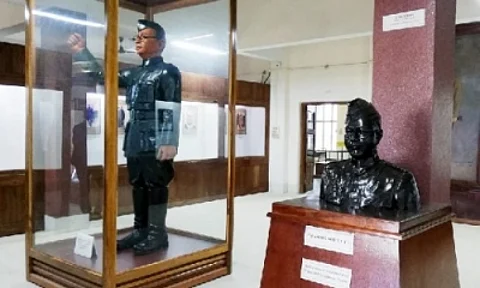A few local leaders went to meet them and ushered them in to Moirang, where Col Malik hoisted the Tricolour on April 14, 1944, with a springing tiger on it, at the historic Moirang Kangla (an ancient spot for the ceremonial coronation of the kings).
Thus, Moirang became the second place on Indian soil where the Azad Hind flag was hoisted, the first being in Port Blair in the Andamans where Netaji hoisted it on December 30, 1943.
The INA Museum in Moirang, inaugurated on September 23, 1969, has a collection of priceless letters, invaluable photographs, badges of ranks and other war memorabilia that reminds the visitors of the sacrifices made by the INA soldiers under the charismatic leadership of Subhas Chandra Bose.
Union Home Minister Amit Shah had on January 6 hoisted the Tricolour at the INA headquarters at Moirang on a 165 feet high pole.
Not only in Manipur's Moirang, villagers of different Nagaland villages specially at Ruzazho and Chesezu villages, both in Phek district, kept the legacy of Subhas Chandra Bose alive.
According to Dr Samudra Gupta Kashyap, a veteran Guwahati-based author and journalist, Ruzazho is a small village, which a section of local people claim, was liberated from the British by the Azad Hind Fauj or INA in April 1944.
The Azad Hind government is said to have 'administered' it for a few months thereafter, with local historians claiming that Netaji had himself visited the Naga Hills, had spent a few days at Ruzazho, and had also appointed a local youth Vesuyi Swuro as a dobashi (interpreter).
The INA had apparently also set up a small operational base at Ruzazho for some time in 1944 till the defeat of Japanese forces in the Battle of Kohima.
A house, said to be where Netaji had stayed, is preserved as also some artefacts of the Azad Hind Fauj, Kashyap told IANS referring to the villagers and historians.
Kashyap, in his recent book titled 'Untold Stories of the Freedom Struggle from Northeast India', said on October 21, 1943, Netaji formed the Provisional Government of Free India in Singapore.
In March 1944, when Japan decided to attack British India, the focus was directly on Manipur, and for that matter the entire north-eastern region.
While the 1,15,000-strong Fifteenth Army of Japan was directed towards India, three Japanese divisions and one division of the INA were the first to make a combined march from Myanmar to Manipur.
The book said that on March 18, 1944, the INA moved from Burma (Myanmar) into India through Manipur, targeting Imphal and Kohima.
The objectives of the Japanese and the INA were different. While the Japanese invasion was intended as a 'pre-emptive strike' to prevent British attempts to take back Burma, Netaji's idea was that once Imphal and Kohima were captured, the INA would march into Assam and Bengal, where they would receive a hero's welcome, and the Indian national movement to oust the British would receive a massive boost, the author said in his book.
The INA soldiers marching alongside the Japanese troops chanted the mantra "Chalo Dilli" and sang "Kadam kadam barhaye jaa" while crossing the India-Burma border to step onto Indian soil. The goal was to see the Indian flag flutter atop the Red Fort in Delhi by driving out the British, Kashyap said in the book.
There is a list available of prominent Nagas who had rendered valuable assistance to the Azad Hind Fauj during the siege of Imphal and Kohima. They include Hepuni Asikho, Kaikhu Angami, Kevialia, Kapuphizo, Kaikho, Raisung, Nikhino Mao, Saunglou and a young woman called Shiningla.
Each of the three Japanese divisions had a regiment of the INA with it. Netaji's concept was that once the INA marched onto Indian soil, it would further intensify the freedom movement. Prior to that, Manipur had already had the first experiences of the Second World War when two powerful Japanese bombs were dropped on Imphal on May 10 and 16, 1942, leading to a number of civilian casualties.
Prisoners escaped from the jail, banks, treasuries and markets were looted, educational institutions shut down, and prices of essential commodities skyrocketed. Most people left the capital and Imphal became a ghost town.
The combined Japanese-INA forces stepped into Indian territory on March 18, 1944 through the southern hills, and the World War finally reached Manipur.
Kashyap said that 32 Manipuris who were working in Myanmar, not only joined the INA under the leadership of L. Guno Singh, but were also part of the advance party to enter Manipur.
Of them, M Ahanjao Singh, B Balhop Sharma, M Chaoba Singh and S Yaima Singh were arrested in Churachandpur, and shifted to Kolkata, from where they were released only after the war ended.
Many Kuki youth on the other hand were enrolled as informers, porters, civil suppliers and soldiers, the author said.
In Tripura, to pay rich tribute to Netaji, a mammoth, colourful procession on the occasion of the iconic freedom fighter's birth anniversary on January 23 has been held for the past 74 years, the largest of its kind in India.
The procession, organised every year by Netaji Subhas Vidyaniketan, portrays themes like Netaji's contribution and role in India's freedom struggle, the dream of freedom fighters of a united India, the country's cultural diversity and unity, harmony among Hindus and Muslims, conservation of water, prevention of child marriage, empowerment of the girl child and awareness about differently-abled children and others.
(SJ/IANS)


